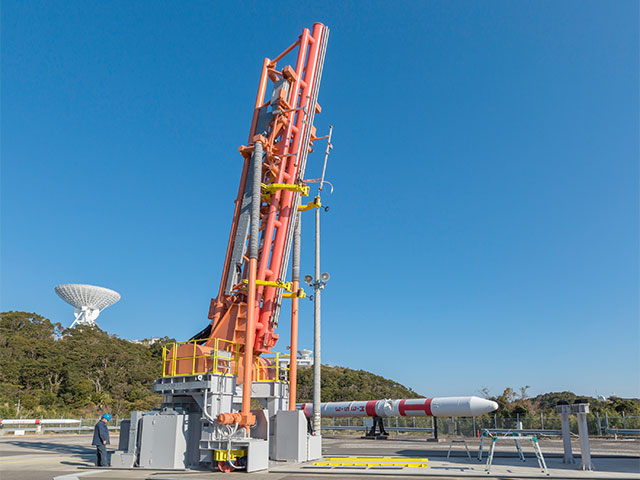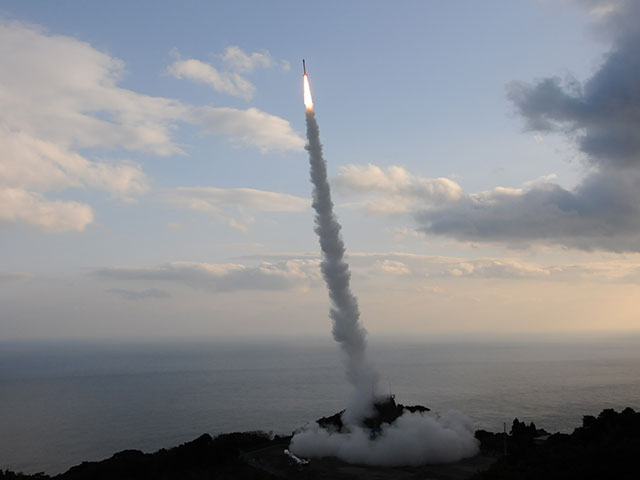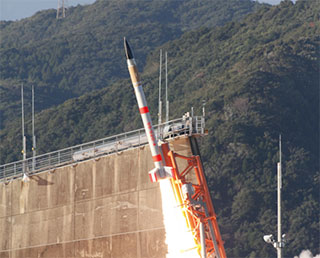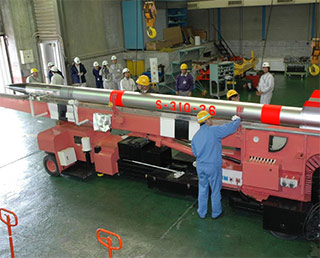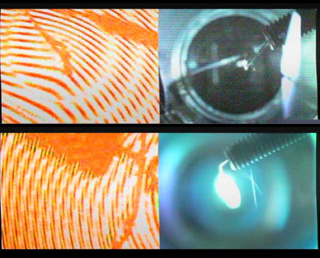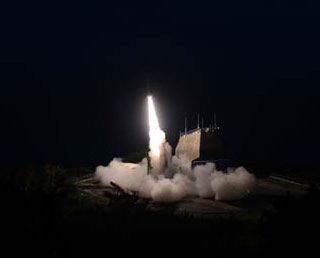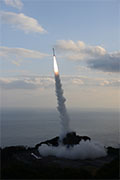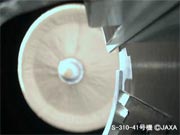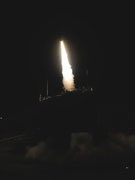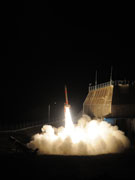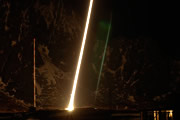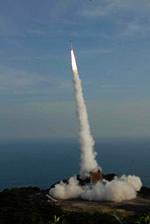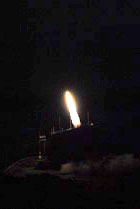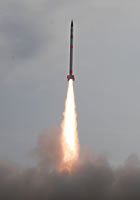Feb. 3, 2018 Updated
Successful Launch Experiment, SS-520 No. 5, Followed by Separation of Payload TRICOM-1R and Orbital Insertion
Exactly at 2:03 pm (Japan Standard Time) at the JAXA Uchinoura Space Center, JAXA experimented SS-520 No. 5 launch with a microsatellite TRICOM-1R aboard.
After liftoff, flight of SS-520 No. 5 proceeded normally. Around 7 minutes 30 seconds into flight, TRICOM-1R separated and was inserted into its target orbit.
SS-520 No. 5 launch experiment was the second attempt following the failure of SS-520 No. 4, which occurred in January 2017. Identification of the error and subsequent countermeasures resulted in the success of No.5 launch experiment. The No. 5 launch experiment was carried out to demonstrate the technology used for small satellite launcher.
|
|
Feb. 1, 2018 Updated
New launch date and time of SS-520 No. 5/Microsatellite decided
The launch experiment time of the microsatellite aboard SS-520 No. 5 was set for 2:03 on February 3 (Sat.), 2018 (Japan Standard Time). The SS-520 No. 5 is a three-stage rocket that is a modification of the SS-520 two-stage sounding rocket.
JAXA will broadcast a live launch report from the Uchinoura Space Center from 1:45 a.m. on the day. You can watch it through the Internet. Please have a look!
Photo: New launcher for SS-520 No.5 at KS center
|
|
Jan. 25, 2017 Updated
Is there little metallic iron in the universe?
Solid particles containing iron (dust particles) act to promote the formation of molecules in interstellar space, and are key to understanding physical and chemical processes there.
Iron contained in dust particles comes in various forms such as metallic iron and iron oxide, each with different properties. Previous studies have suggested that iron is present mainly in forms other than iron oxide, iron carbide, and iron sulfide. To verify the possibility that metallic iron is present, a research team led by Dr. Kimura (Hokkaido University) performed in situ observations of gaseous iron cooling in a microgravity environment, and investigated the ease of iron aggregation (the efficiency at which metallic iron forms).
The experimental results showed that, unlike in the results of ground experiments, it was difficult for iron atoms to aggregate. In other words, it is difficult for metallic iron to form in outer space.
The team speculates that iron in dust particles is not a metal, but rather contained as a compound, or adhered to other particles as an impurity.
The results of this research were published in the online journal Science Advances of the American Association for the Advancement of Science on 21 January 2017.
|
|
Jan. 15, 2017 Updated
SS-520 No. 4 Launch Results
At 8:33 a.m., (Japan Standard Time) January 15, 2017, SS-520 No. 4, JAXA's sounding rocket launched from the Uchinoura Space Center. Through SS-520 No. 4 launch, JAXA sought for research and development of launch vehicles and satellites and the launch demonstration of TRICOM-1, its onboard nanosat that weighs about 3 kilograms. The launch was part of Japanese government's program for development of launch vehicles and satellites in public-private partnerships.
The first stage flight of SS-520 No. 4 proceeded according to schedule. Thereafter, however, ground teams could not receive telemetry from the launch vehicle and the call was made to abort the second stage ignition.
JAXA tracked the launch vehicle and confirmed that it fell into the south eastern ocean off the Uchinoura Space Center, within the projected drop area.
|
|
Jan. 15, 2016 Updated
The launch results of the S-310-44 sounding rocket
On Friday, January 15, JAXA launched the S-310-44 sounding rocket from the Uchinoura Space Center. The launch had the objective of “The Clarification of the Heated Phenomenon of Ionospheric Plasma”.
The flight was a success and the S-310-44 dropped into the southeastern ocean off Uchinoura.
The ensuing experiment will clarify the heated phenomenon which occurs in the proximity of the focus of Sq current system (*), generated in the lower ionosphere. Therefore, the detailed measurements were performed on the plasma and the electric and the magnetic fields in the high temperature layer. JAXA and other institutes will thoroughly analyze the observation data. (Photo: S-310-36 sounding rocket)
(*) Sq current system: the electric current in the lower ionosphere, which originates with the atmospheric movement. The energy input from the sun generates the movement.
|
|
Sep. 11, 2015 Updated
Launch result of S-520-30 sounding rocket
JAXA successfully launched the S-520-30 sounding rocket from the Uchinoura Space Center on September 11 (Fri.), 2015, with the objective of “clarifying the nucleation process of oxide-based cosmic dusts”.
The flight went smoothly, and the onboard instruments worked properly.
After completing its mission, the S-520-30 dropped into the south eastern ocean off Uchinoura Through the experiment this time, we evaporated oxides under the micro-gravity environment by ballistic flight of the S-520-30, and directly measured the generation and growth process of oxide particles that were condensing after the evaporation.
|
|
Aug. 17, 2014 Updated
Launch Result of S-520-29 Sounding Rocket
JAXA launched the S-520-29 sounding rocket from the Uchinoura Space
Center on August 17 (Sunday), 2014, with the objective of the
"stereoscope observation of Sporadic E layer space structure." The
experiment was successful.
The S-520-29 dropped into the south eastern ocean off Uchinoura after
its normal flight and operation of onboard experiment instruments.
|
|
Dec. 17, 2012 Updated
S-520-28 launch completed
JAXA launched the sounding rocket S-520-28 at 4:00:00 p.m. on December 17, 2012 (Japan Standard Time) from the Uchinoura Space Center. The launch aims at conducting a homogeneous nucleation experiment* using the microgravity environment. The vertical angle at the launch was 76 degrees and the experiment went smoothly as planned. The flight and operation of the onboard equipment went well, and, at 10 seconds after liftoff, the nucleation experiment with calcium carbonate started, then at 100 seconds, the nucleation reproduction test started as planned.
The sounding rocket then reached its maximum altitude of 312 km at 283 seconds after liftoff, then dropped into the south eastern ocean off Uchinoura. The acquired data this time will be analyzed in detail.
*In the homogeneous nucleation experiment, we aimed at observing nucleation, which was the first phase of crystallization, by utilizing the microgravity environment during the first few minutes of flight while the sounding rocket was on a ballistic trajectory, then to understand the physics of nucleation. In addition, the experiment also had a purpose of acquiring basic data for future long-term tests to be held repeatedly at the International Space Station.
|
|
Aug. 7, 2012 Updated
S-310-41 launch completed
JAXA launched the sounding rocket S-310-41 at 4:30:00 p.m. on Aug. 7, 2012 (Japan Standard time) from the Uchinoura Space Center. The purpose of the launch was a flight experiment of the small inflatable capsule. The vertical angle at the launch was 81 degrees.
The flight and operation of the onboard devices were all normal, and its top part (the nose fairing) opened at the preordained timing of 60 seconds after liftoff, reached its highest altitude of 150 km at 191 seconds, then dropped onto the south eastern ocean of Uchinoura.
The onboard experiment device, the small inflatable capsule, released its aero-shell cover at 90 seconds after liftoff as scheduled, and started injecting gas at 95 seconds, then separated from the launch vehicle at 100 seconds to be released. The capsule sent various observation data namely temperature, pressure, acceleration, attitude and images to the ground station for about 20 minutes while descending.
The acquired data will be further analyzed in detail.
Image: Capsule released from the launch vehicle (three seconds after separation)
|
|
Jan. 12, 2012 Updated
S-520-26 launch result
JAXA launched the sounding rocket S-520-26 at 5:51 a.m. on January 12, 2012 (Japan Standard Time) from the Uchinoura Space Center. The vertical angle at the launch was 72.5 degrees. The S-520-26 was designated to clarify the combining process of the neutral atmosphere and plasma in the thermosphere.
The rocket flew smoothly, and opened its top part (the nose fairing) at 56 seconds after liftoff to start observations at 58 seconds. When it reached its maximum altitude of 298 km at 278 seconds, the lithium emission system was ignited to release lithium vapor to be dropped into the south eastern ocean of Uchinoura.
One of the onboard devices (the ion mass energy analyzer) did not perform observations successfully, but other devices, including an impedance probe, Langumuir probe, beacon transmitter, electromagnetic measurement device, and solar sensor, worked properly throughout the ascending and descending of the rocket. Reddish clouds due to lithium gas released from the rocket were seen for about 30 minutes from the ground observation points in Uchinoura, Shukumo, and Muroto. The acquired data this time will be analyzed in detail.
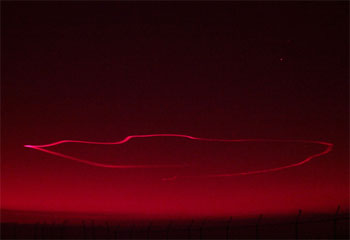
Photo: Reddish clouds due to lithium gas emitted from the rocket (6:16 a.m. from Uchinoura)
|
|
Dec. 20, 2011 Updated
S-310-40 launch result
JAXA launched the sounding rocket S-310-40 at 11:48 p.m. on Dec. 19, 2011 (Japan Standard time) from the Uchinoura Space Center. The vertical angle at the launch was 76 degrees. The S-310-40 was designated to analyze radio wave propagation in the mid-latitude ionosphere during the night.
The flight and operation of the onboard devices were all normal, and its top part (the nose fairing) opened at the preordain timing of 60 seconds after liftoff, reached its highest altitude of 180 km at 210 seconds, then dropped onto the south eastern ocean of Uchinoura after completing its observation missions.
All onboard devices worked properly throughout the ascending and descending, and, at about 80 seconds, the high electron density area was observed at an altitude of around 103 km. It means that the rocket passed through the expected high density plasma area.
We are currently analyzing acquired data for more details.
|
|
Aug. 31, 2010 Updated
S-520-25 successfully launched
The sounding rocket S-520-25 was successfully launched at 5:00 a.m. on August 31, 2010 (Japan Standard Time,) from the Uchinoura Space Center. The vertical angle at the launch was 82.5 degrees. The S-520-25 was designated to conduct basic experiments on the electro-dynamic tether (EDT) in the ionosphere and to control the attitude of a robot using a tether under the micro-gravity environment while the rocket was making a sub-orbit flight for about 10 minutes to reach its maximum altitude of some 300 km.
The rocket flew normally, and, at 55 seconds after liftoff, its top part opened, and at 58 seconds, the plasma measurement probe (FLP, SSP) was deployed to start observations. The conductive tether was extended at about 120 seconds, and the extension image was transmitted to the ground through the Ku telemetry. The Tethered Space Robot (TSR) was separated from the auxiliary unit of the rocket (DAU) at 297 seconds, and its attitude was controlled by the TSR arm until 310 seconds after liftoff. Concerning the plasma collection experiment, we were able to successfully extend the conductive tether and boom and verify the high-speed ignition function of the Hollow Cathode (HC) despite the fact that the high-voltage control was not carried out as scheduled, thus we have gained a perspective to develop a more efficient plasma collection device.
The S-520-25 rocket reached a maximum altitude of 309 km at 283 seconds after liftoff, completed all observation projects, and fell down to the ocean south-east of Uchinoura.
|
|
Jan. 26, 2009 Updated
S-310-39 successfully launched!
JAXA successfully launched the S-310-39 rocket at 9:15 a.m. on January 26, 2009 (Japan Standard Time, JST, or 1:15 a.m. local time) from the Andoya Rocket Range (Norway) with a launch angle of 77.5 degrees. The purpose of the S-310-39 launch is to study the dynamics and energetics in the lower polar thermosphere under the effects of aurora activities.
The rocket flight and time sequence were normal, and the yo-yo despinner system was actuated 56 seconds after liftoff, and at 61 seconds, the nose cone was opened. According to an early report from the Andoya Range, the rocket carried out its scheduled observations after reaching an altitude of 140 km, and splashed down in the northern ocean of Andoya.
Detailed data analysis will be performed later in Japan.
Image: At the moment of the launch (at the Andoya Rocket Range)
|
|
Aug. 2, 2008 Updated
S-520-24 observation rocket successfully launched!
The observation rocket S-520-24, which aims to uncover the mechanism for crystal growth utilizing a microgravity environment during its flight, was launched at a vertical angle of 78.4 degrees at 17:30 on August 2, 2008 (Japanese Standard Time) from the Uchinoura Space Center.
The rocket's flight and on-board equipment all performed normally and the nose-cone was opened 55 seconds after launch. The rocket reached an altitude of 293 kilometers high in 274 seconds from the launch and all the experiments were completed. The rocket then descended to its scheduled ocean landing area southeast of Uchinoura.
Two pieces of equipment for the crystal growth experiment aboard the rocket were operated normally and acquired data.
A detailed analysis will be later performed using the acquired data.
|
|
Feb. 7, 2008 Updated
Launch success of "S-310-38"
JAXA launched the sounding rocket "S-310-38" at 6:14:40 p.m. on February 6, 2008, from the Uchinoura Space Center to observe three dimensional plasma distribution up to an altitude of 150 km. The launch angle was 72.4 degrees.
The rocket flight and operations of its onboard equipment all went as expected, and, at 60 seconds after liftoff, the top part of the rocket opened as scheduled to start observations at 62 seconds. The rocket then reached its highest altitude of 157 km at 196 seconds, released its chaff at 298 seconds to complete its observation mission, and fell into the sea southwest of Uchinoura.
The data acquired through the experiment will be analyzed in detail and the results will be released later.
|
|
Jan. 16, 2007 Updated
Launch success of "S-310-37"
On January 16, the sounding rocket "S-310-37" was launched at 11:20 a.m. from the Uchinoura Space Center. The purpose of the rocket is to elucidate the mechanism of the generation of the high electron temperature sphere in the lower part of the ionosphere.
The flight and operation of the on-board equipment went normally, and at 59 seconds after liftoff, the top part of the rocket opened.
Subsequently, the rocket started observations at 60 seconds. All observations were completed after it reached its highest altitude of 138 km at 184 seconds, then it fell into the sea south-east of Uchinoura.
The experiment went smoothly as planned, and through the on board electronic temperature measurement equipment we have confirmed that the high-temperature sphere existed at an altitude of 99 to 101 km.
|
|

